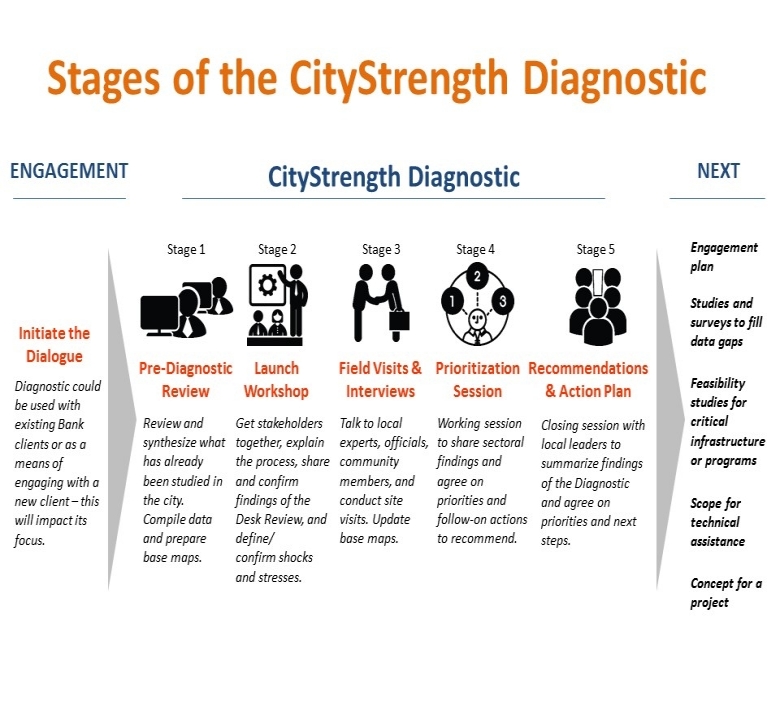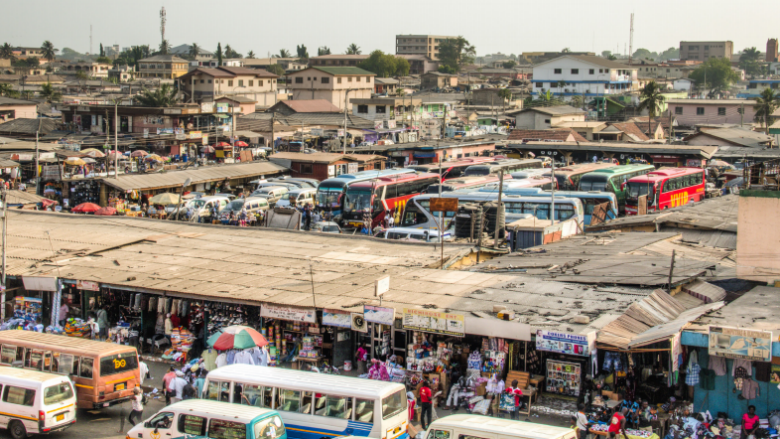Click to view: Overview | Stages of Implementation | Sectoral Modules | Applications | Blogs | Collaboration on Urban Resilience | Download CityStrength Guideboook
Overview
With most of the global population and capital goods concentrated in urban areas, cities are key to social development and economic prosperity. They are drivers of national economic growth and innovation, and act as cultural and creative centers. But rapid and unplanned urbanization also brings challenges that are exacerbated by the effects of climate change. With a greater concentration of people, assets and infrastructure in urban areas, an increasingly complex range of shocks and stresses can put in jeopardy human wellbeing and hard-won development gains.
Within this global context and with support from the Global Facility for Disaster Reduction and Recovery (GFDRR), the CityStrength Diagnostic was developed in 2014 to help World Bank staff apply this new holistic approach to urban resilience to operations. It was designed to help facilitate a dialogue among stakeholders (e.g. government, civil society, residents, and the private sector) about risks, resilience, and the performance of urban systems. The CityStrength Diagnostic results in the identification of priority actions and investments that will enhance the city’s resilience as well as increase the resilience-building potential of planned or aspirational projects. It promotes a holistic and integrated approach that encourages cross-sectoral collaborations to more efficiently tackle existing issues and to unlock opportunities within the city.
The CityStrength Diagnostic is structured around sectoral modules that cover topics within the city and metropolitan area purview. Because cities depend on a complex network of infrastructure, institutions, and information, the CityStrength Diagnostic first evaluates sectoral resilience and then brings together the findings to identify interlinkages that determine the resilience of the city holistically. The end result of the process is a prioritized list of structural and non-structural actions to enhance the overall resilience of the city as well as to increase the resilience-building potential of planned and aspirational projects.
The CityStrength Diagnostic has been implemented in 28 local governments. It was first piloted in two cities – Can Tho, Vietnam and Addis Ababa, Ethiopia— which provided two very different contexts for assessing the benefits of the process. The CityStrength Diagnostic was then implemented at the metropolitan level in 16 municipalities that make up the Greater Accra Region in Ghana, as well as in nine regional capitals and a charter city in Ethiopia.
Back to top
Stages of Implementation
The CityStrength Diagnostic consists of 5 stages, book-ended by leadership commitment for resilience on the front-end and a longer-term engagement with development partners through financing or technical assistance at the back-end. The CityStrength Diagnostic can be implemented using a rapid or incremental approach, which will dictate how long will the process take and how many sectorial modules will be included in the process.
Stage 1 focuses on collecting information, and leveraging efforts that have already been undertaken in the city. A review of all relevant studies, reports, or plans developed by the city, the World Bank, or other development partners is conducted. Who prepared it? Why? And how was it used? Key findings are summarized in order to brief participants during the Launch Workshop as well as Bank specialists supporting the implementation of the diagnostic. Specific background studies or data collection initiatives, including hazard mapping and urban growth trends, could also be undertaken during this stage depending on the context.
Stage 2 is a Launch Workshop. The objectives of the workshop are to 'officially' launch the CityStrength Diagnostic process in the city, to explain the concept of urban resilience, to learn about the city's goals and objectives, to verify the initial findings from the first stage, to introduce the multi-sectoral Bank team, and to engage with a broad set of stakeholders.
Stage 3 consists of interviews and site visits to help the Bank specialists better understand the challenges and opportunities in the city and to qualitatively assess how well key systems are performing in relation to defined Qualities of Resilience. It is also meant to give the city departments the opportunity to learn about each other’s work programs and ongoing resilience activities.
Stage 4 is the identification and prioritization of actions and investments to enhance resilience in the city. This is done using multiple “lenses” to qualitatively identify measures that the Bank specialists recommend as the most important for the city leaders to consider. While the ultimate goal of the CityStrength Diagnostic is to enhance the city’s long-term resilience, it is important to understand the nature of any immediate threats to people and assets (Lens 1). It is also crucial to understand dependencies and interdependencies within urban services and systems, which can cause cascading disruption or failure, or compound existing vulnerabilities (Lens 2). Thinking holistically (rather than sectorally) about the city’s resilience (Lens 3) is necessary to identify critical gaps or areas of weakness at the city scale. Finally, aligning recommended actions and investments with local goals and objectives (Lens 4) increases the likelihood that the recommendations will have sufficient stakeholder support to become a reality.
Stage 5 is continued dialogue with local leadership and other stakeholders to present the findings of the diagnostic, discuss recommendations, and agree on priorities and next steps. A description of the process and recommendations can then be captured in a publication that the city can use for internal purposes or as a tool to seek funding from development partners.
Long-term Engagement. The diagnostic will identify specific actionable projects that can be implemented by the city with the technical or financial support of the World Bank or other development partners. Like all World Bank activities, decisions about the World Bank’s role will be driven by the government and relevant Country Management Unit (CMU).
Back to top
Sectoral Modules
Back to top
Applications
The CityStrength Diagnostic has been piloted in multiple contexts.
Accra, Ghana
The World Bank and the Global Facility for Disaster Reduction and Recovery (GFDRR) conducted a CityStrength Diagnostic in Accra, Ghana in 2016 at the request of the government of Ghana. The objective of the CityStrength Diagnostic was to engage a wide range of stakeholders across Metropolitan, Municipal, and District Assemblies (MMDAs) in Greater Accra Metropolitan Area (GAMA) and other government agencies to jointly identify the root causes of the many shocks and stresses confronting the GAMA region, as well as to identify priority actions and investment to address them.
Can Tho, VietnamThe World Bank and the Global Facility for Disaster Reduction and Recovery (GFDRR) conducted a CityStrength Diagnostic in Can Tho, Vietnam in June 2014 at the request of the city. A team of specialists from the World Bank Group worked with local officials, technical staff, and stakeholders to identify priorities for investment and appropriate areas for action to help build resilience in Can Tho.
Addis Ababa, Ethiopia
The World Bank and the Global Facility for Disaster Reduction and Recovery (GFDRR) conducted a CityStrength Diagnostic in Addis Ababa, Ethiopia, in February 2015 at the request of the city. A team of specialists from the World Bank Group worked with local officials, technical staff, and stakeholders to identify priorities for investment and appropriate areas for action to help build resilience in Addis Ababa.
Back to top
Blogs
Back to top
Collaboration on Urban Resilience
The World Bank is a member of the Medellin Collaboration on Urban Resilience and the Cities Alliance’s Joint Work Programme on Resilient Cities. They are both partnerships with other international institutions with the purpose of facilitating the flow of knowledge and financial resources to help cities become more resilient to disruptions related to climate change, disasters caused by natural hazards, and other systemic shocks and stresses – including the socio-economic challenges associated with rapid urbanization. Both partnerships are essential as nations prepare for the implementation of the 2030 Sustainable Development Agenda, the Sendai Framework for Disaster Risk Reduction, the Paris Agreement on Climate Change, and the New Urban Agenda, and they will help by:
- Strengthening local governments by harmonizing, developing, and piloting tools to integrate resilience into city planning and development strategies;
- Ensuring urban poor groups are at the center of citywide resilience solutions;
- Catalyzing access to existing and innovative finance mechanisms, including risk-based instruments, to reduce exposure and vulnerability to shocks and increase cities’ adaptive capacity; and
- Supporting capacity development of cities to achieve their goals by facilitating the direct sharing of best practices and knowledge enhancement.
In January 2017, the members of the Medellin Collaboration and the Joint Work Programme on Resilient Cities, with support from a grant from the Cities Alliance, launched an online platform called “ResilienceTools.org” to help local governments and city stakeholders find and understand the wide range of tools and diagnostics designed to assess, measure, monitor, and improve city-level resilience. CityStrength is included among the tools showcased. Furthermore, the platform features case studies of cities that have implemented the different tools and their subsequent results.
Back to top






















